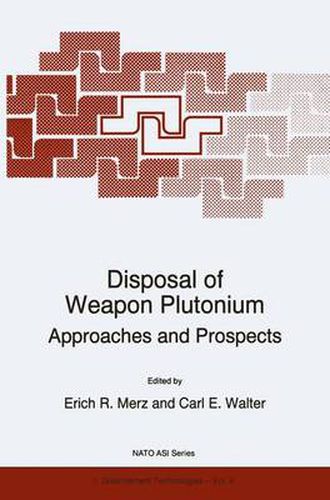Readings Newsletter
Become a Readings Member to make your shopping experience even easier.
Sign in or sign up for free!
You’re not far away from qualifying for FREE standard shipping within Australia
You’ve qualified for FREE standard shipping within Australia
The cart is loading…






This title is printed to order. This book may have been self-published. If so, we cannot guarantee the quality of the content. In the main most books will have gone through the editing process however some may not. We therefore suggest that you be aware of this before ordering this book. If in doubt check either the author or publisher’s details as we are unable to accept any returns unless they are faulty. Please contact us if you have any questions.
This NATO Advanced Research Workshop on Disposal of Weapons Plutonium is a follow-up event to two preceding workshops, each dealing with a special subject within the overall disarmament issue: Disposition of Weapon Plutonium , sponsored by the NATO Science Committee. The first workshop of this series was held at the Royal Institute of International Affairs in London on 24-25 January 1994, entitled Managing the Plutonium Surplus, Applications, and Options . Its over all goal was to clarify the current situation with respect to pluto nium characteristics and availability, the technical options for use or disposal, and their main technical, environmental, and economic constraints. In the immediate term, plutonium recovered from dismantled nuclear warheads will have to be stored securely, and under international safeguards if possible. In the intermediate term, the principal alter natives for disposition of this plutonium are: irradiation in mixed oxide (MOX) fuel assemblies in existing commercial light-water reac tors or in specially adapted light-water reactors capable of operation with full cores of MOX fuel .and irradiation in future fast reactors. Another option is to blend plutonium with high-level waste as it is vitrified for final disposal in a geologic repository. In both cases, the high radioactivity of the resulting products provides self shielding and prevents separation of plutonium without already developed and available sophisticated technology. The so-called spent fuel standard as an effective protection barrier is - quired in either case.
$9.00 standard shipping within Australia
FREE standard shipping within Australia for orders over $100.00
Express & International shipping calculated at checkout
This title is printed to order. This book may have been self-published. If so, we cannot guarantee the quality of the content. In the main most books will have gone through the editing process however some may not. We therefore suggest that you be aware of this before ordering this book. If in doubt check either the author or publisher’s details as we are unable to accept any returns unless they are faulty. Please contact us if you have any questions.
This NATO Advanced Research Workshop on Disposal of Weapons Plutonium is a follow-up event to two preceding workshops, each dealing with a special subject within the overall disarmament issue: Disposition of Weapon Plutonium , sponsored by the NATO Science Committee. The first workshop of this series was held at the Royal Institute of International Affairs in London on 24-25 January 1994, entitled Managing the Plutonium Surplus, Applications, and Options . Its over all goal was to clarify the current situation with respect to pluto nium characteristics and availability, the technical options for use or disposal, and their main technical, environmental, and economic constraints. In the immediate term, plutonium recovered from dismantled nuclear warheads will have to be stored securely, and under international safeguards if possible. In the intermediate term, the principal alter natives for disposition of this plutonium are: irradiation in mixed oxide (MOX) fuel assemblies in existing commercial light-water reac tors or in specially adapted light-water reactors capable of operation with full cores of MOX fuel .and irradiation in future fast reactors. Another option is to blend plutonium with high-level waste as it is vitrified for final disposal in a geologic repository. In both cases, the high radioactivity of the resulting products provides self shielding and prevents separation of plutonium without already developed and available sophisticated technology. The so-called spent fuel standard as an effective protection barrier is - quired in either case.